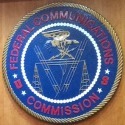
US officials appear to be putting the final touches on what some analysts believe will be the nation's biggest spectrum auction ever.
Perhaps not surprisingly, 5G sits at the heart of the matter. Although the network technology can work in a wide variety of spectrum bands, many in the industry argue that midband spectrum -- roughly between 2.5GHz and 6GHz -- is ideal for 5G. And the FCC, the government agency charged with commercial spectrum management, appears to be in the final stages of designing rules around how to auction the C-Band, a massive strip of spectrum between 3.7GHz and 4.2GHz.
A C-Band auction could raise at least $50 billion in gross bids, according to a new calculation from the Wall Street analysts at New Street Research. At such a level, it would make the auction the biggest ever for the US in terms of total bids.
At $50 billion, the C-Band would be far bigger than the FCC's most recent spectrum auctions, of 24GHz and 28GHz licenses totaling $2.7 billion that ended earlier this year. It would be bigger than the agency's 600MHz incentive auction in 2017 totaling around $20 billion. It would even be bigger than the massive $45 billion AWS-3 spectrum auction in 2015, which is so far the biggest FCC auction ever, towering over the agency's $13.7 billion AWS-1 auction in 2006 and its $18.9 billion 700MHz auction in 2008.
"We believe the C-Band is the most important spectrum band to come to market in a decade, if not the most important licenses since the original cellular licenses were granted in the 1980s," the New Street analysts wrote in a recent report to investors. However, they acknowledged that it's difficult to assess the value of spectrum, and the amount of money raised in any C-Band auction would depend on how much spectrum is up for grabs.
Prime electromagnetic real estate
The C-Band has often been described as "Goldilocks" spectrum because it strikes just the right balance between coverage and capacity. Unlike lowband spectrum (which supports broad geographic coverage but cannot carry much data) or highband spectrum (which carries plenty of data but cannot cover much territory), signals in midband spectrum like the C-Band can cover miles of ground while carrying enormous amounts of data.
Indeed, according to recent testing by cable company Midco using equipment from vendor Telrad, the operator can provide fixed wireless Internet speeds over C-Band spectrum of 200Mbit/s on the downlink and 40Mbit/s on the uplink.
And that's why the analysts at New Street believe a wide range of telecommunications companies -- from AT&T to Verizon to Dish Network to T-Mobile to Comcast to Charter Communications -- will bid on C-Band spectrum. The analysts argued that some will bid to improve their existing networks, some will bid to prevent competitors from obtaining too much spectrum, and some will bid to embark on new business opportunities -- but they are all expected to bid.
"The biggest driver of C-Band's value to the market is the fact that it simply is a lot of spectrum: there are 180MHz on offer, compared to ~700MHz held by the major national carriers today," the analysts wrote. "C-Band is also unpaired; if 75% of the C-Band were used for downlink (it could be higher), C-Band will represent 26% of all industry downlink spectrum. Because it is unpaired spectrum with a high enough frequency, C-Band can take advantage of 5G technologies like massive MIMO and beamforming, driving higher spectral efficiency than current carrier spectrum, which is deployed with a mix of 2G, 3G, and 4G technologies."
FCC racing forward
According to comments this week by two of the agency's five commissioners, the FCC will lay out the ground rules for a C-Band auction this fall. "We're also working on the complicated task of freeing up spectrum for 5G in the 3.7-4.2GHz band, commonly called the C-Band. This is a critical band for 5G, and I'm optimistic that we will have results to show on this front this fall," FCC Chairman Ajit Pai said without providing any details.
What's unclear though is exactly how the FCC will release the C-Band for auction. The spectrum is currently used by satellite companies and others to deliver TV and other content to Americans around the country. Those operations would need to be re-ordered for C-Band spectrum to be freed up for 5G.
Already a group of satellite companies have teamed up under the banner of the C-Band Alliance (CBA) with a proposal to auction the spectrum outside of the auspices of the FCC. Although critics have blasted the CBA's proposal as foreign satellite companies profiting from the sale of American radio waves, FCC Commissioner Michael O'Rielly indicated he favors the CBA's proposal because it would release spectrum for 5G more quickly.
"The argument has been made that it is unfair for these private, foreign satellite companies to receive all of the proceeds from any spectrum auction, private or public," O'Rielly said. "In the end, my primary concern is getting the C-Band reallocation done as expeditiously and thoughtfully as possible so it can advance the US 5G efforts. If someone or some entities make a profit for being in the right place at the right time, I will live with that outcome. In the grand scheme of things, if it is a contest between speed and the government trying to extract a significant piece of the transaction through a lengthy process, I’ll take the speedy resolution."
The analysts at New Street previously predicted the FCC would vote in November on the C-Band issue.
— Mike Dano, Editorial Director, 5G & Mobile Strategies, Light Reading | @mikeddano
About the Author(s)
You May Also Like











